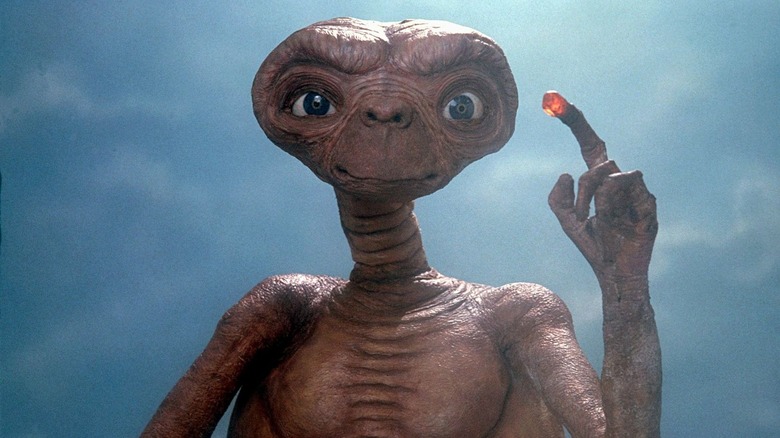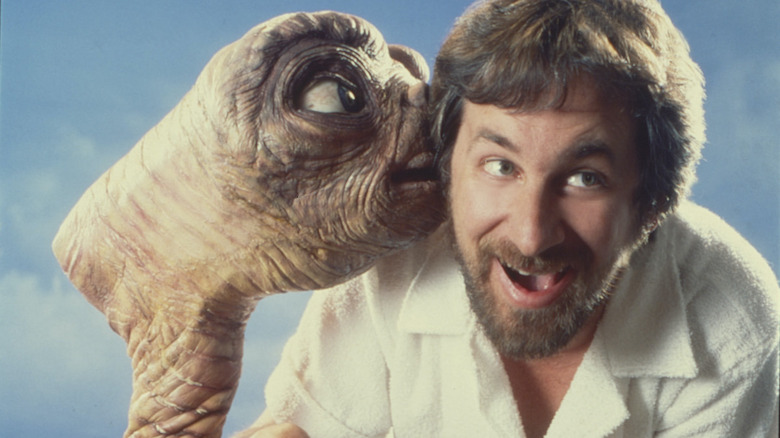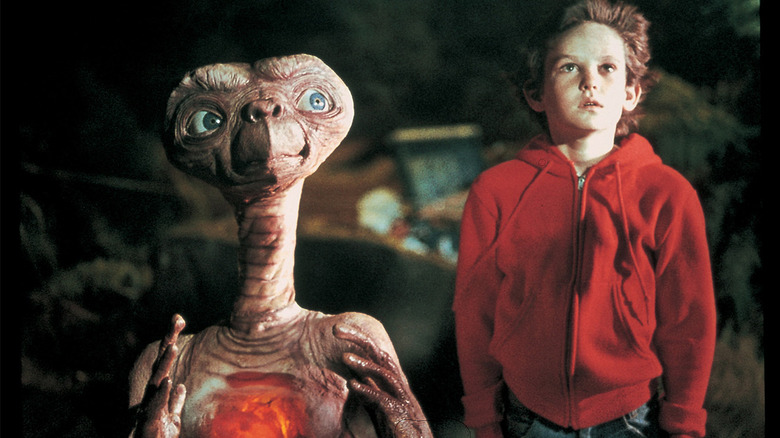E.T. Was Originally Going To Be A Horror Movie – But Steven Spielberg Saw A Different Path
"E.T. the Extra-Terrestrial" is a sentimental ode to the magic of childhood that exemplifies the exhilarating power of cinema. But it wasn't always supposed to be an uplifting family-friendly adventure; it was originally planned to be quite the opposite — a horror film. After the success of "Close Encounters of the Third Kind," a thoughtful meditation on human nature with some eerie moments, Columbia wanted to make a sequel. Steven Spielberg had no interest, but after the release of the middling "Jaws 2" from Universal, directed by Jeannot Szwarc, he wanted to be involved somehow.
Spielberg wrote a treatment entitled "Watch the Skies" (the original title for "Close Encounters") based on the famed Kelly-Hopkinsville encounter. A Kentucky family claimed they witnessed strange lights in the sky and then were terrorized by stout "goblins" peering in their windows. Spielberg first heard this strange story from Josef Allen Hynek, a UFOlogist who worked on "Close Encounters." After "Watch the Skies" was renamed "Night Skies" because someone owned the rights to the phrase, Spielberg wrangled genre legend John Sayles, who had just written "Piranha" for director Joe Dante, to flesh out the screenplay.
Sayles' draft depicted a small group of malicious aliens — Squirt, Skar, Klud and Hoodoo — that threaten a rural family and brutally kill livestock with one touch of their long, bony finger, which emits an eerie light (this device is used in "E.T." in a very different way). The kind-hearted alien Budde befriends the family's autistic son Jaybird, and their sweet, playful scenes are moments of respite from the overall terror. The worst alien is Skar, a bird-like creature with grasshopper eyes inspired by the villain in John Wayne's "The Searchers." The Bedlam Files commends Sayles un-filmed script: "Sayles sets up the personalities and dilemmas of this clan with admirable economy (horror novelists would do well to study this script) while keeping the overall focus on the steadily developing alien invasion narrative."
With the screenplay in hand, Spielberg suggested that Tobe Hooper, best known for "The Texas Chain Saw Massacre," direct the film, and he hired special effects legend Rick Baker to create the alien creatures. Baker's model of the lead alien impressed Spielberg when he saw videotape footage during the filming of "Raiders of the Lost Ark." But Spielberg began to have doubts about "Night Skies."
Spielberg wanted to make a gentle film
In the book "The Films of Steven Spielberg" by Neil Sinyard, Spielberg confessed he was growing weary of dark, thrilling stories during the early 1980s:
"I might have taken leave of my senses. Throughout [the production of] Raiders, I was in between killing Nazis and blowing up flying wings and having Harrison Ford in all this high serialized adventure. I was sitting there in the middle of Tunisia, scratching my head and saying, 'I've got to get back to the tranquillity, or at least the spirituality, of Close Encounters.'"
"Night Skies" was not that type of project. Luckily for Spielberg, he read the script to screenwriter Melissa Mathison, who loved the friendly connection between the boy and alien. The storyline moved her to tears because (per "The Films of Steven Spielberg") "the idea of an alien creature who was benevolent, tender, emotional and sweet... and the idea of the creature's striking up a relationship with a child who came from a broken home was very affecting." Spielberg teamed up with Mathison to create what was originally titled "E.T. and Me." It was exactly the kind of tender-hearted film that Spielberg had been wanting to make, one that was inspired by his own youth as a child of divorce.
This sudden pivot infuriated Rick Baker, who had just spent $700,000 on alien prototypes for "Night Skies," leading "Close Encounters" special effects creator Carlo Rambaldi to work on "E.T." instead. After Hooper turned "Night Skies" down, Spielberg gave the directing position to production designer Ron Cobb. In the Los Angeles Times, Cobb seems bitter about his missed chance, calling the final film "a sentimental and self-indulgent, a pathetic lost-puppy kind of story."
According to the book "Steven Spielberg: A Biography" by Joseph McBride, Columbia was against making "a wimpy Walt Disney movie" (via Den of Geek). Contractual agreements were made so that Spielberg fulfilled his "Close Encounters" follow-up with a special edition release. Universal purchased the rights for "E.T. the Extra-Terrestrial" and repaid Columbia the $1 million that had been used to develop "Night Skies," as well as a deal to retain 5% of the film's net profits. The agreement certainly paid off when "E.T." made over $600 million worldwide during its initial release (via Box Office Mojo).
Night Skies lives on
John Sayles explains in "Steven Spielberg: A Biography" that his draft of "Night Skies" was "more of a jumping-off point than something that was raided for material. I thought [Mathison] had done a great job." Although it was never fully put on screen, "Night Skies" lives on in many other Spielberg projects. In "Poltergeist," Steven Spielberg produced (and possibly directed) alongside original "Night Skies" director Tobe Hooper, suburbanites are threatened by mysterious supernatural forces, instead of intergalactic menaces. Spielberg told author Joseph McBride that both projects could be interpreted as the juxtaposing poles of his own psyche:
"'Poltergeist' is what I fear and E.T. is what I love. One is about suburban evil, and the other is about suburban good ... "Poltergeist" is the darker side of my nature — it's me when I was scaring my younger sisters half to death when they were growing up."
The idea of nefarious, short, goblin-like creatures causing anarchy on unsuspecting families came to fruition in 1984's "Gremlins," executive produced by Spielberg and directed by Joe Dante. Another similarity to "Night Skies" were the different personalities of the gremlins. Much like Budde, Gizmo is cute and friendly and Spike mirrors Skar's wicked nature.
Shortly after "E.T." was released in 1982, Spielberg worked on a follow-up with Mathison entitled "E.T. II: Nocturnal Fears." Their 10-page treatment detailed evil aliens coming to earth and kidnapping Elliott and his friends. These predatory extra-terrestrials are E.T.'s enemies who had been at war with his alien race for decades. This would have been a much darker turn for a sequel and Spielberg (thankfully!) realized that it would take away from the innocence and wonder of his original masterpiece. Spielberg would explore ruthless, malevolent aliens in his 2005 adaptation of "War of the Worlds."
The journey from "Night Skies" to "E.T. The Extra-Terrestrial" took many turns. While we may have missed out on John Sayles original ideas, some of them were able to be used in other exciting projects. We are very lucky that "E.T." came to fruition; it is difficult to imagine Spielberg's filmography without this deeply personal and spellbinding fairy tale.


